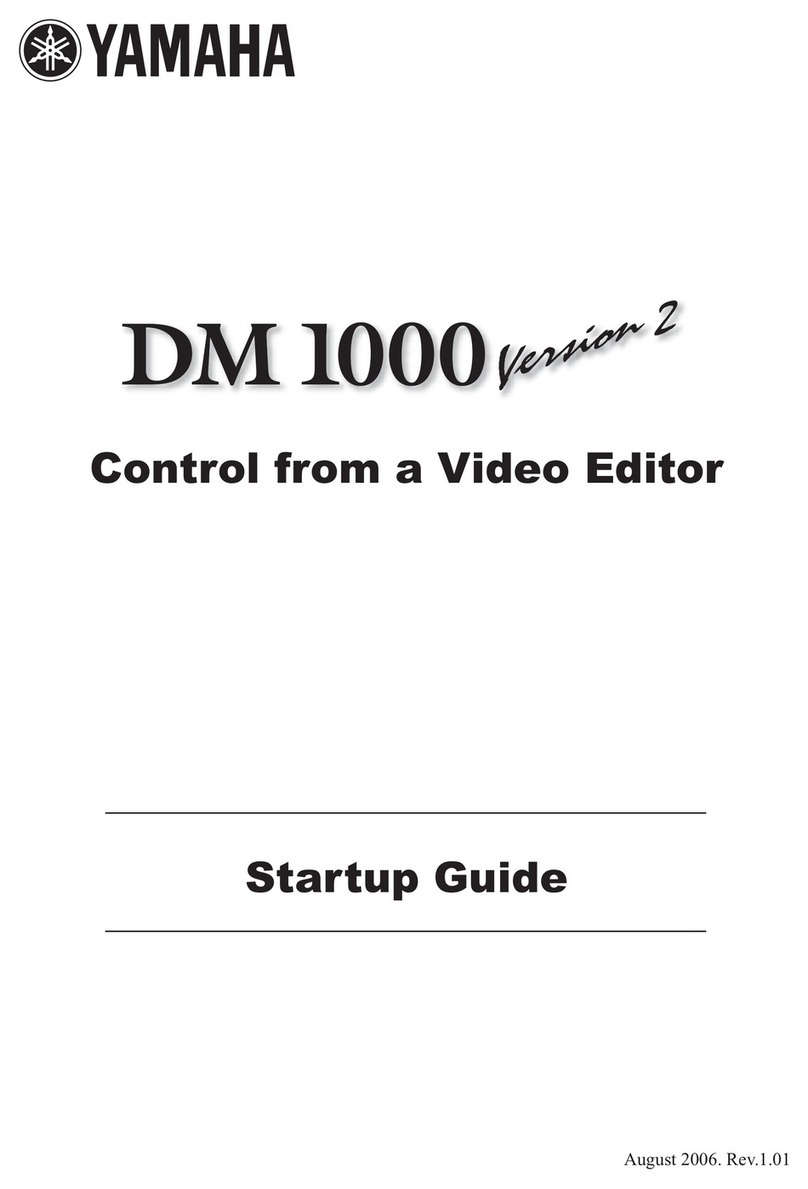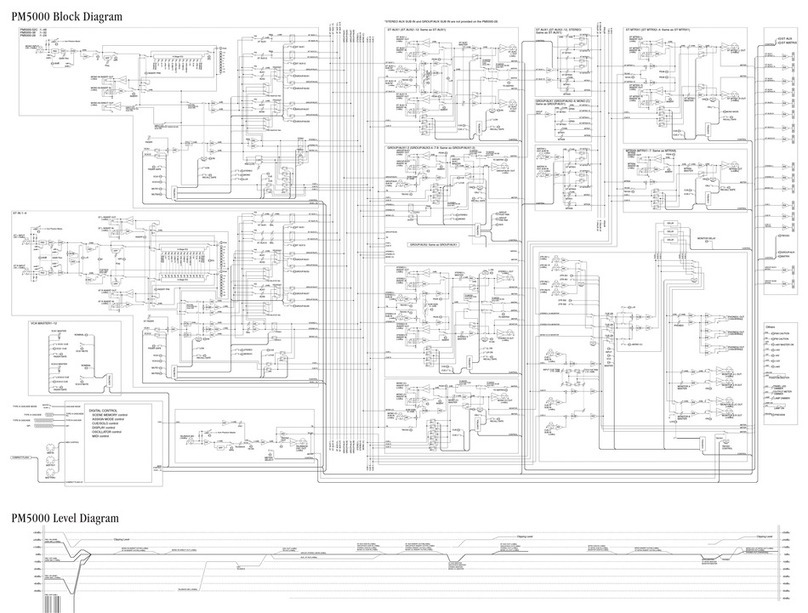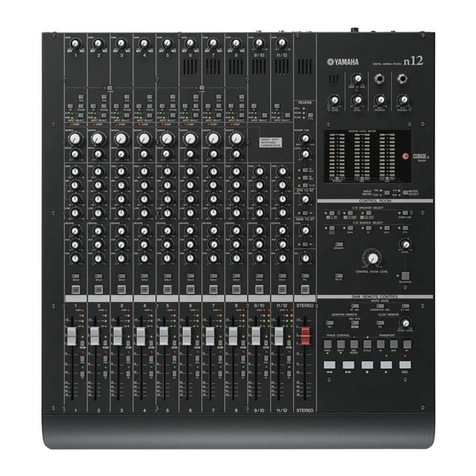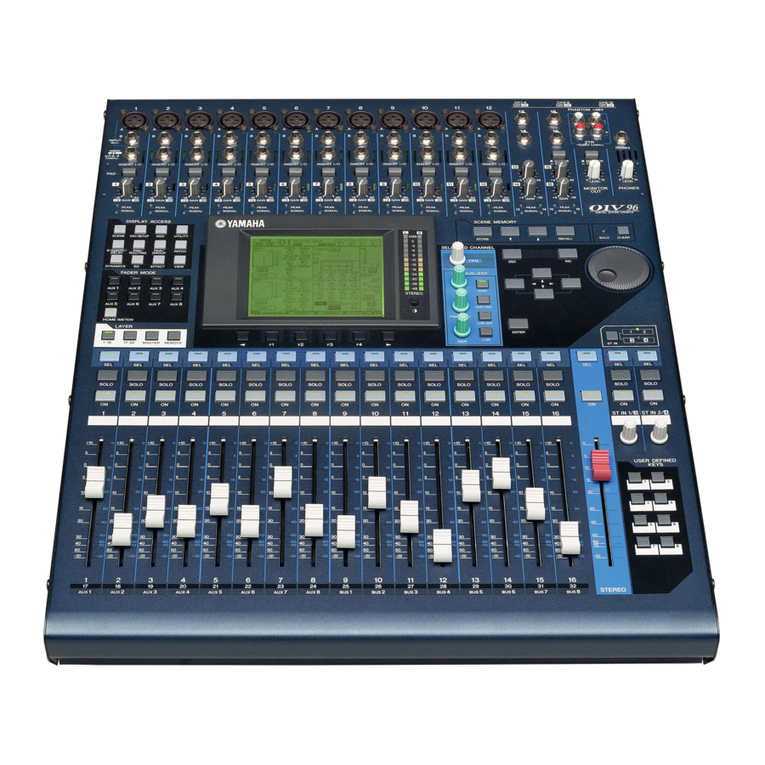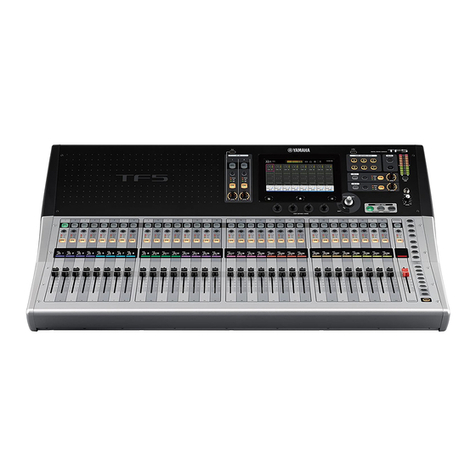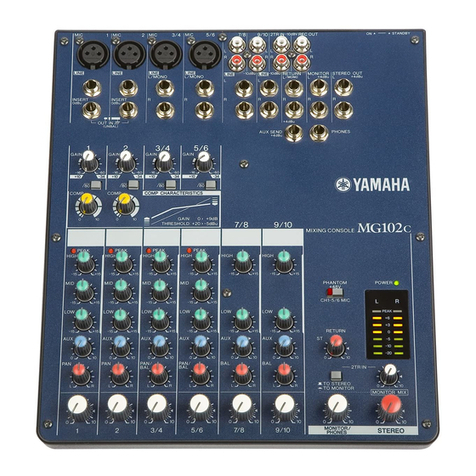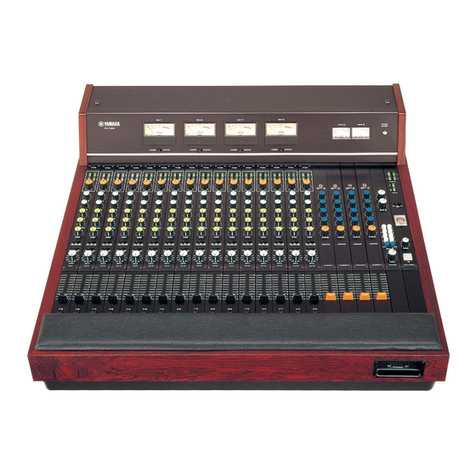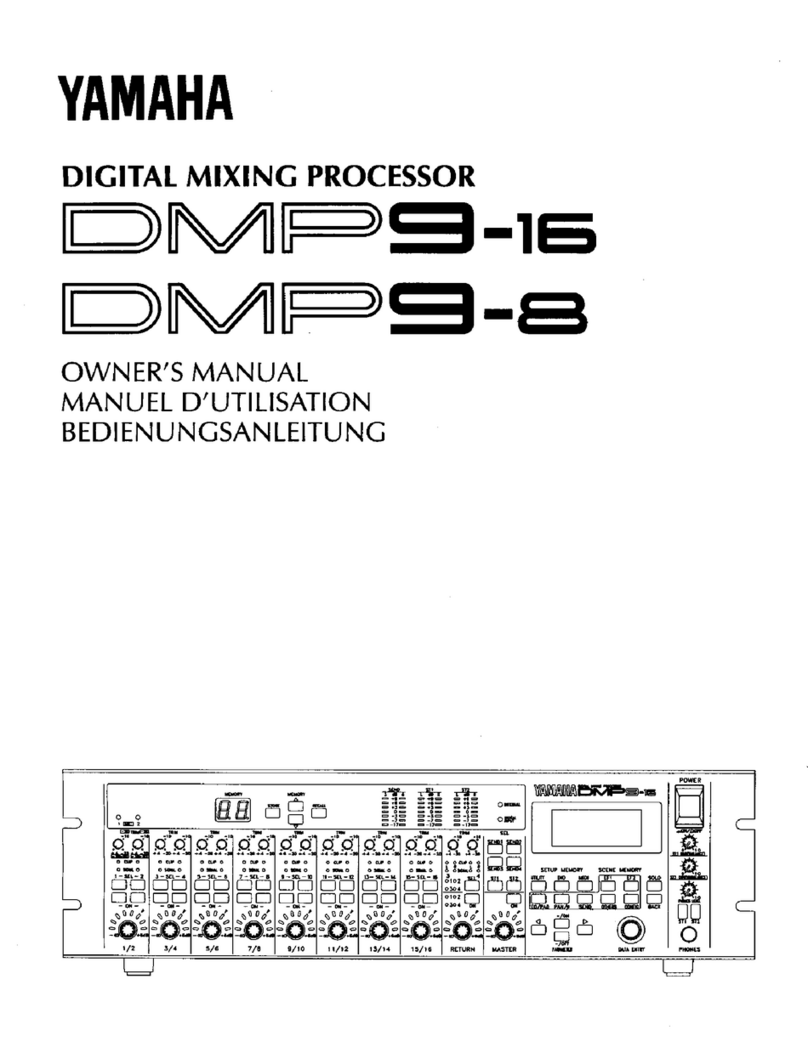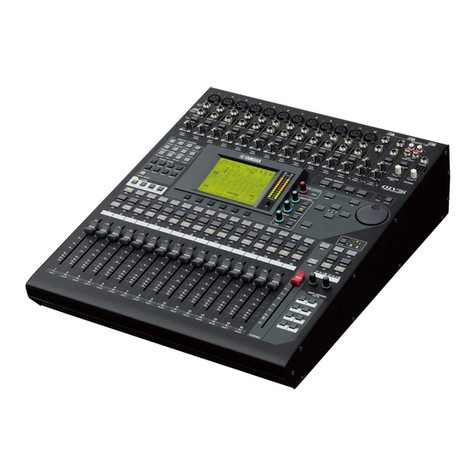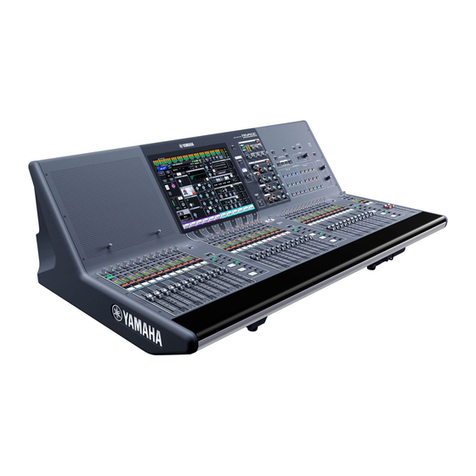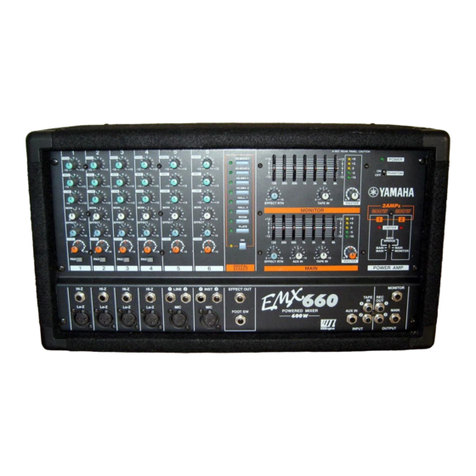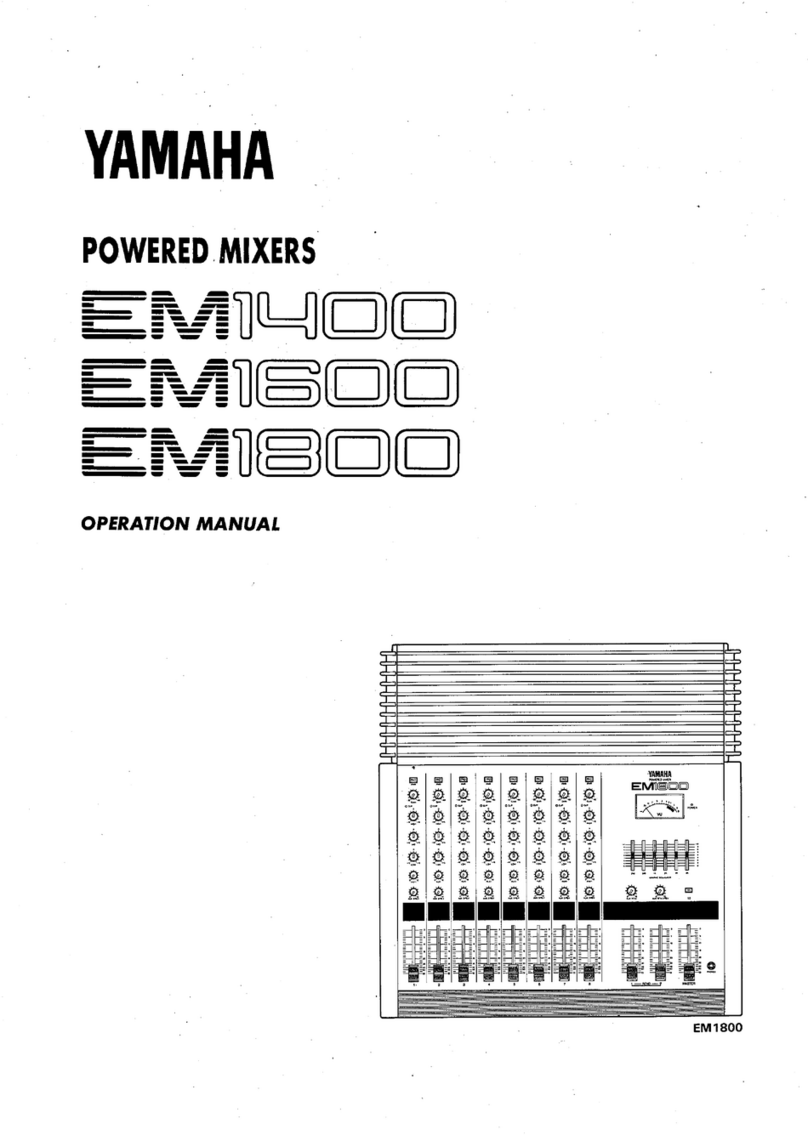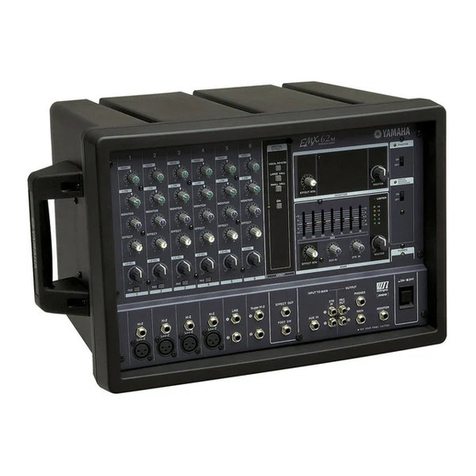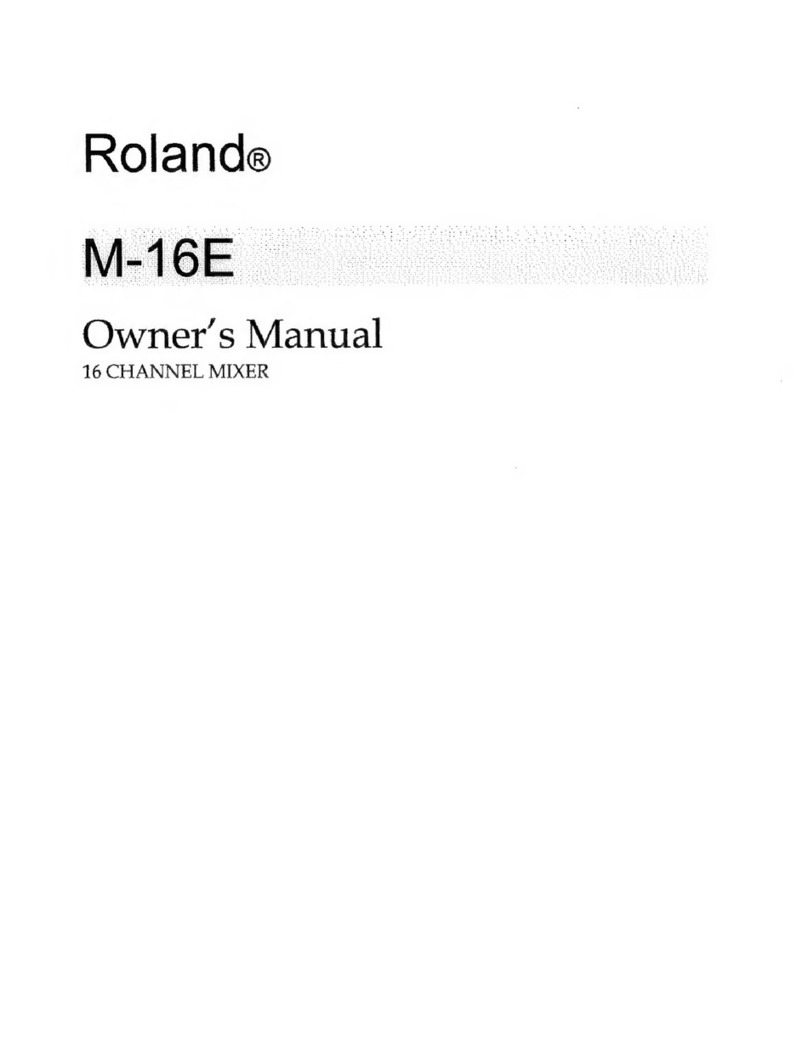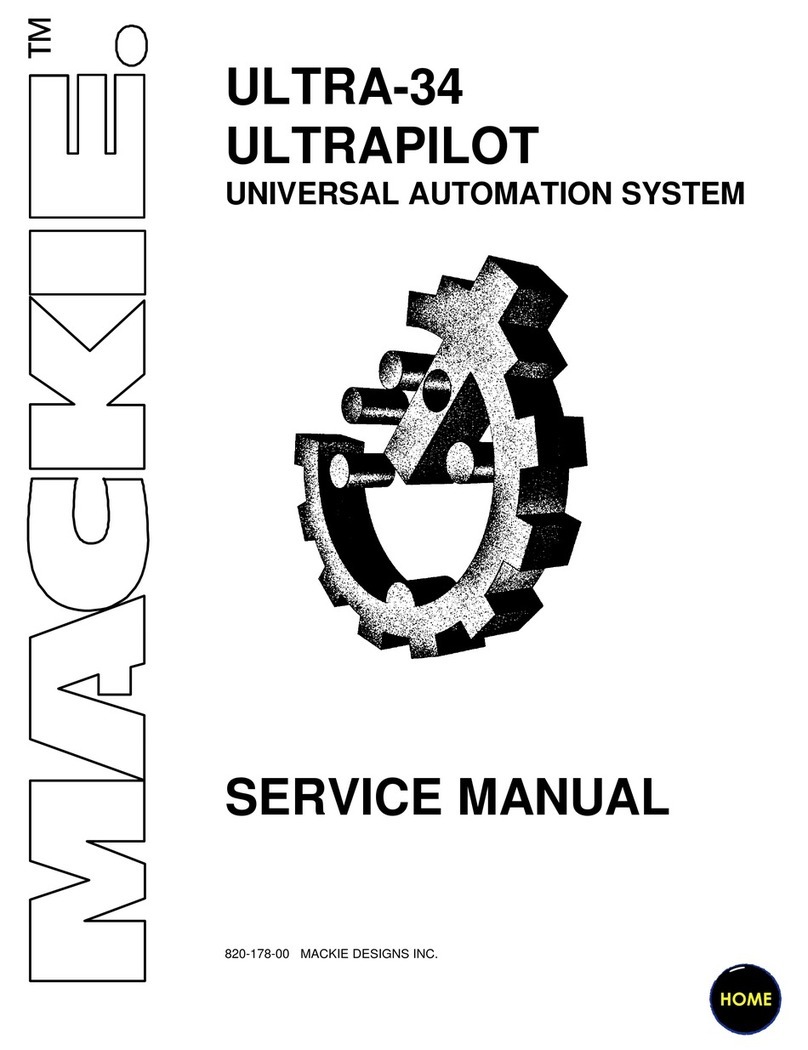DIGITAL PRODUCTION CONSOLE DM2000DIGITAL PRODUCTION CONSOLE DM2000
GLOBAL PASTE
GLOBAL PASTE
AUTOMIX STATIC INSERT
AUTOMIX STATIC INSERT
MACHINE CONTROL
REMOTE USR DIFINED KEY
INPUT MUTE GROUP
OUTPUT MUTE GROUP
5. Scene Memory
This although simple and concise,
the DM2000’s SCENE MEMORY
section will undoubtedly see a lot
of use. It’s here that you can store
all console parameters as a new
scene, or instantly recall
previously-stored scenes. A numeric display
right next to the STORE, RECALL, and
UP/DOWN keys shows the current scene
number — 01 through 99. Additional scene
memories can be managed via memory
cards or a computer running the supplied
Studio Manager software. Like most other
control sections, a DISPLAY key brings all
scene parameters up on the LCD display
panel. And for even greater versatility
Version 2 features a global paste function
that lets you simultaneously paste selected
parameters from one scene to multiple
scenes – your EQ and AUX settings from
final rehearsal, for example, can easily be copied to all other scenes that will
be used during the performance. Fade time and recall safe settings can also be
copied to multiple scenes in one easy operation.
6. Automix
Automated mixdown has become a major part of modern production. That’s
why most automix functions have been made directly accessible from the
DM2000 console rather than being relegated to hard-to-find display screens.
Without even looking at the display you can write and enable automation for
the console’s faders, channel on/off switching, panning, surround positioning,
aux levels and on/off switching, and EQ. Writing automation requires as much
concentration as real-time mixdown, and by providing a comprehensive
AUTOMIX section Yamaha have made the job considerably easier. Versatility is
further enhanced in Version 2
with an automix static insert
function that allows pre-defined
parameter settings to be punched
in and out to, for example, adjust
the EQ for a short dialog
sequence during pre-production. Version 2
additionally includes a fader touch-sense
function that allows automix parameter
punch in/out operations to be carried with
unprecedented speed and efficiency. When
a fader is touched the parameter for that
fader is punched in and the automix
parameter overwrite mode is engaged. Two
modes are provided: in the TOUCH mode
the fader parameter is punched out and
overwrite ends when the fader is released,
and in the LATCH mode overwrite continues
even after the fader is released.
7. User Defined Keys
These 16 keys can be assigned to
control any functions you choose.
You could, for example,
individually mute surround
monitor speakers, directly recall
scene memories, etc. When the Pro
Tools®Remote Layer mode is selected, the
USER DEFINED KEYS are automatically
assigned to Pro Tools®control functions by
default. Version 2 adds the capability to
assign group master mute to the user
defined keys. Any of the console’s inputs and
outputs can be assigned to mute groups as
required, then muting of the assigned group
can be engaged or disengaged with one
touch via the user defined keys – a
tremendous advantage in live sound
applications. Instant Group Assignment via
the User Defined Keys enables you to quickly
set up fader groups and mute groups. User
Defined Bank F is preset for input group
assignment. If you select a channel, the
relevant User Defined Keys light up if the
channel is in a fader or mute group. You
can press a User Defined Key to add a
channel to a group or exclude a channel
from a group.
8. Machine Control
Since the DM2000 will almost certainly be used with some sort of multitrack
recorder — tape, hard-disk, or DAW — it has been provided with a
comprehensive range of facilities for external machine control. Both Sony
9-pin (P2) and MMC protocols are supported, and control can be switched
between MTR and master target machines. Version 2 provides additional
control capability with the ability to
remotely control MMC and P2 equipment
directly from the console’s DAW layer, so
you can simultaneously control a DAW and
MMC/P2 recorders without having to switch
layers. The DM2000’s machine control
features are divided into three main
sections, as summarized below:
8-1. Transport Controls
Standard transport controls in the
familiar layout — REW, FF, STOP,
PLAY, and REC — for fast, efficient transport operation.
8-2. Locator
All the locator controls you would
normally find on an advanced
locator panel — plus a few extras
— are duplicated right here on
the DM2000 console.
TRACK ARMING GROUP
USER ASSIGNABLE LAYER
8-3. Track Arming
24 track arming (record on/off) buttons can be used directly for up 24 tracks
on a single recorder, or to control track arming on three separate 8-track
recorders. Additionally, up to four complete track-arming setups can be
memorized and recalled via TRACK ARMING GROUP keys A through D.
9. Channel Strips
The 24 channel strips on the DM2000 panel provide access to
the most essential operations for the corresponding channels.
Depending on the currently selected layer, the channel strips
will control channels 1 through 24, 25 through 48, 49 through
72, or 73 through 96. Also the channel faders and encoders
will function according to the settings in the FADER MODE and
ENCODER MODE sections. In addition to a fader and rotary
encoder, each
channel strip
includes a channel
ON/OFF key, a SOLO
key, and AUTO key
to turn mix
automation on or
off for that channel,
and a SEL key which assigns the channel as the console’s
“Selected Channel”. Detailed control for the currently selected
channel — dynamics, EQ, buss assignment, panning and
surround positioning, aux/matrix sends,
delay, and phase/insert — is available via
the SELECTED CHANNEL controls.
10. Master & Layer Section
In addition to the master stereo fader with its own ON, SEL
and AUTO keys, the master section includes keys for input
channel layer selection (Master Layer 1-24, 25-48, 49-72,
73-96) as well as selectors for four remote control layers.
Using the “User Assignable Layer” feature you can create a
custom layer to which any channels can be assigned in a
preferred layout, and the setups can be stored in any of four
banks. This system means
that you have a total of 96
channels and buses right
in front of you in the space
of 24.
11. Data Entry
When it does become necessary to get into detailed numeric parameter
editing, the DM2000 makes the task as easy as possible. Large cursor,
INC/DEC, and enter keys are complemented by a data entry dial that lets you
spin in values quickly and easily. The data entry
dial also doubles as a shuttle/scrub dial for
recorder or DAW control. A
PC-compatible computer
keyboard can also be directly
connected to the rear-panel
keyboard connector for extra
data entry ease and
convenience.
12. Analog Input Section
No digital console is completely free of analog circuitry, and any analog that
does exist must be of the highest quality so as not to negate the performance
potential of the digital system. The DM2000 features 24 high-performance
head amplifiers for microphone or line input that deliver a pristine signal to
the console’s precision 24 bit/96 kHz A/D converters. These head amplifiers
are the result of extensive development and field testing, and deliver
transparent performance that rivals – and in many cases exceeds –that of the
most expensive component microphone preamplifiers. 48-volt phantom
power for condenser microphones is individually switchable for
each input, trim controls and pad switches facilitate optimum
level matching with the source, and switchable inserts
make it easy switch external analog processing gear into
or out of the pre-A/D signal path.
13. Meter Bridge
The MB2000 Peak Meter Bridge is a complete level-monitoring station for the
DM2000. 48 12-segment level meters can be used individually or in pairs
to display pre-EQ, pre-fader, or post-fader input channel signal levels. The
same meters can also display levels on the console’ s eight buses, 12 auxiliary
sends, and four stereo matrix buses. A separate 32-segment stereo meter is
provided for the main stereo program. The MB2000 also features a time-code
display for complete, centralized visual monitoring.
14. Rear Panel
A quick look at the rear panel should tell you that the DM2000 is designed for
serious production. Balanced XLR and TRS connectors are provided for all 24
inputs, and rather than the common single TRS jacks for unbalanced

